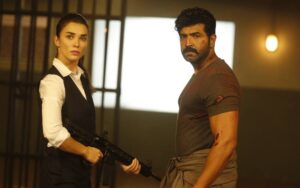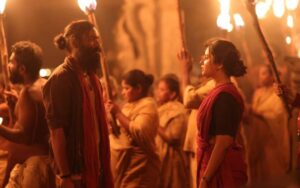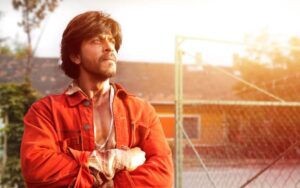Review: Baahubali 2 -The Conclusion
The verdict is out and as expected! Baahubali 2 – The Conclusion is as magnificent!!!

Baahubali 2 – The Conclusion is as magnificent as the beginning, if not better.
Director Rajamouli proves yet again why he is considered one of the finest story tellers of our times by narrating a fascinating tale that is spread over two generations and three kingdoms in a span of less than six hours.
The second part begins exactly where the first ends — Sivagami’s proclamation of Amarendra Baahubali as future king of Mahishmathi. From then, it is just a fascinating journey as the tale unfolds. She advises Baahubali to mingle with the masses before assuming charge. This, she says, is necessary as a ruler must be aware of the problems that plague the common man. So, dressed as ordinary citizens, the future emperor sets out with Kattappa as his companion to travel the length and breadth of his empire. Soon, they arrive at Kundala desam, one of the smaller kingdoms under Mahishmathi. It is here that they see princess Devasena (Anushka Shetty) putting to sword bandits and retrieving stolen property. Amarendra Baahubali is impressed and falls in love with her. However, they are now dressed as common men. Unwilling to disclose their true identity, both Baahubali and Kattappa find a way to accompany the princess to her palace. There, after a very interesting set of developments, Baahubali too realises that Devasena has fallen for him. But even as Baahubali is busy courting Devasena, his rival, Vallala Deva is busy collecting news from spies on what he is upto. News of his courtship reaches Vallala Dheva (Rana Daggubatti), who too falls for Devasena just by looking at her picture.
Even before one realises it, Vallala Deva comes up with a master plan along with his dad Pinjala deva (Nasser) to ensure that he wins Devasena’s hand. His plan looks to exploit his mother Sivagami’s weakness, which in this case is her eagerness to make up for proclaiming Amarendra Baahubali as king and for making him only the Chief of the armed forces. He also looks to exploit her lack of information and puts to good use the fact that she is unaware that both Baahubali and Devasena are in love with each other. He extracts a promise from Sivagami that Devasena will be his. It is exactly at this time, that Baahubali promises Devasena that he will defend her honour. At one point, both of those who have made promises come in conflict with one another and there arises a situation where only one will be able to stay true to their word. Who manages to keep their word? Who ends up breaking it? What does the person who breaks the promise do? Why does Kattappa eventually kill Baahubali? How does Mahendra Baahubali take revenge for his father’s death? Baahubali 2- The conclusion answers all of these questions and more.
The second part has so many developments that there is a twist here and a turn there almost every second minute of the two hour and forty minute long film. Each development is new and totally unexpected – this, despite one being aware of where the story is finally going to end. Rajamouli and the editor of the film, Kotagiri Venkateswara Rao have done a brilliant job, compressing a massive epic into a compact story and laying it out on the giant screen for the masses. The very manner in which the story, with all its details, has been laid out deserves applause.
Next, although the story has hundreds of developments, the film’s unit has paid attention to even small details of each development. And when we say small details, these don’t pertain to just the story or the plot or the actors. These even pertain to the make up and the CG. For instance, Nasser as Pinjala Deva, chooses to show his strength in one scene. He strikes a pillar with his right arm and the force of the blow makes a portion of a pillar come off. Although the camera does not zoom in to Nasser’s fist, one is still able to spot bruises on his knuckles. Such is the care that has been accorded to make up.
Art director Sabu Cyril can take a bow as the kingdoms and palaces he has designed are nothing short of being marvellous. Be it at a macro level or at a micro level, every single piece that appears on screen – be it the designs on a doorway or the aerial shot of an entire fort or the palaces– is breathtakingly beautiful.
Brilliant performances allround only enhance the stature of this film even more. However, part II has a different set of actors stealing the show. While it was Sathyaraj as Kattappa and Ramya Krishnan as Sivagami who stole the show in part one, Anushka Shetty, Nasser and Rana Daggubatti impress with their performances in part II. Anushka as Devasena is charming and elegant. As a self-righteous princess, who does not hesitate to question wrong decisions, she wins your heart.Prabhas as both Amarendra Baahubali and Mahendra Baahubali impresses. However, his work as Amarendra Baahubali is more impressive than his work as Mahendra Baahubali. Nasser as Pinjala Deva just takes wickedness to another level altogether. Rana as Vallala Deva is arrogant, powerful and fearsome.
Now, finally coming to four of the most important departments of this film — music, cinematography, CG and direction — and not necessarily in that order. Maragathamani’s music is mellifluous in the romantic portions, awe-inspiring in the royal sequences and fear inducing in the battle sequences. The background score is brilliant just accentuating the mood of the story. Cameraman Senthil Kumar’s work is more than magical as his lighting and shots just make the whole screen come alive. The same can be said of the CG department and although one is able to say where CG has been used, the CG sequences in this film are by far the best that we have seen in an Indian movie.
Last but not the least comes the department of direction. To even envisage such a story is incomprehensible. Rajamouli has not only envisaged it, he has actually managed to narrate it in all its glory. For just that, his name is bound to be written in the annals of Indian film history in gold. Make no mistake, this film is bound to be remembered for all eternity as one of the finest films to have ever been attempted by an Indian unit.






